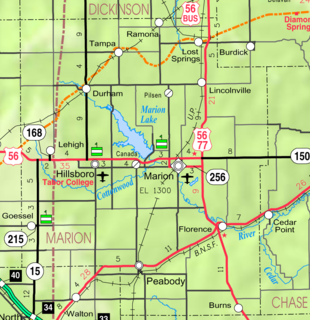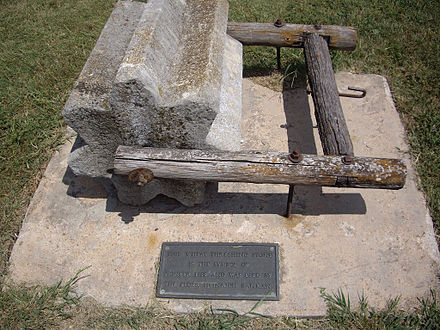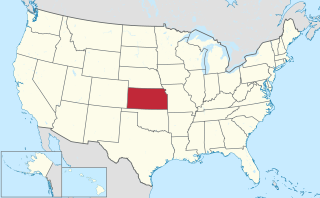
McPherson County is a county located in the U.S. state of Kansas. As of the 2010 census, the county population was 29,180. The largest city and county seat is McPherson. The county is named for Civil War General James B. McPherson.

Marion County is a county located in the U.S. state of Kansas. As of the 2010 census, the county population was 12,660. The county seat is Marion. The county was named in honor of Francis Marion, a Brigadier General of the American Revolutionary War, known as the "Swamp Fox".

Harvey County is a county located in the U.S. state of Kansas. As of the 2010 census, the county population was 34,684. Its county seat and most populous city is Newton.

Halstead is a city in Harvey County, Kansas, United States. Halstead was named in honor of Murat Halstead, a respected Civil War correspondent and newspaper editor. As of the 2010 census, the city population was 2,085.

North Newton is a city in Harvey County, Kansas, United States. As of the 2010 census, the city population was 1,759. The city of Newton is located immediately south, existing as a separate political entity. North Newton is home of Bethel College.

Goessel is a city in Marion County, Kansas, United States. It was named after Captain Kurt von Goessel (1852–1895) who went down with his ship, the Elbe, in the English Channel after it was rammed. As of the 2010 census, the city population was 539.

Hillsboro is a city in Marion County, Kansas, United States. Hillsboro was named after John Gillespie Hill, who homesteaded in the area in 1871. As of the 2010 census, the city population was 2,993. Hillsboro is home of Tabor College, which had 766 students enrolled in Fall 2014.

Inman is a city in McPherson County, Kansas, United States. As of the 2010 census, the city population was 1,377.

Buhler is a city in Reno County, Kansas, United States. As of the 2010 census, the city population was 1,327.

Chaff is the dry, scaly protective casings of the seeds of cereal grain, or similar fine, dry, scaly plant material such as scaly parts of flowers, or finely chopped straw. Chaff is indigestible by humans, but livestock can eat it and in agriculture it is used as livestock fodder, or is a waste material ploughed into the soil or burned.

Martyrs Mirror or The Bloody Theater, first published in Holland in 1660 in Dutch by Thieleman J. van Braght, documents the stories and testimonies of Christian martyrs, especially Anabaptists. The full title of the book is The Bloody Theater or Martyrs Mirror of the Defenseless Christians who baptized only upon confession of faith, and who suffered and died for the testimony of Jesus, their Saviour, from the time of Christ to the year A.D. 1660. The use of the word defenseless in this case refers to the Anabaptist belief in non-resistance. The book includes accounts of the martyrdom of the apostles and the stories of martyrs from previous centuries with beliefs similar to the Anabaptists.

Bethel College is a four-year private Christian liberal arts college in North Newton, Kansas, United States. It is affiliated with the Mennonite Church USA.

The Alexanderwohl Mennonite Church of Goessel, Kansas, is a congregation affiliated with Mennonite Church USA. The congregation has a continuous history dating from 16th-century Europe.
The Schowalter Foundation is a Kansas-based Mennonite philanthropic foundation formed in 1954 from the estate of Jacob A. Schowalter of Newton, Kansas.
Jacob Abraham Schowalter was a Kansas farmer, business owner and Mennonite philanthropist whose estate formed the basis of the Schowalter Foundation.

The Warkentin House is a house in Newton, Kansas, United States. The home of Bernhard Warkentin and Wilhelmina Eisenmayer Warkentin, it was built between 1886 and 1887. It is listed on the Kansas Register of Historic Places and National Register of Historic Places as a splendid example of the Victorian period in American architecture and furnishings. The Victorian house offers a glimpse into the way the Warkentins lived, with 80 percent of the original furnishings remaining.

Gnadenau was a communal village of German-speaking Mennonite immigrants from Russia in Marion County, Kansas, United States. It is currently a ghost town that was located approximately 2 miles (3.2 km) southeast of Hillsboro. No buildings remain at this former community site. The Gnadenau Cemetery still exists.
Jacob Gerhard Ewert, also known as J. G. Evert, was a Mennonite socialist and pacifist from Hillsboro, Kansas. From 1909 he was editor of the German-language newspaper Hillsboro Journal, later renamed Vorwärts. Ewert wrote books and pamphlets on socialism, on temperance, and on warfare. The historian Duane Sotltzfus described Ewert as a "tireless advocate for conscientious objectors, writing articles and counseling many draftees" when writing for Vorwärts. The Newton, Kansas, newspaper Der Herold, edited by H. P. Krehbiel, challenged his published support of socialist agendas.



























